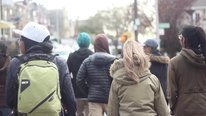- Sharon Lynch
- http://gsehd.gwu.edu/faculty/sharon-lynch
- Opportunity Structures for Preparation and Inspiration in STEM (OSPrI)
- https://ospri.research.gwu.edu/
- George Washington University
- Michael Ford
- Opportunity Structures for Preparation and Inspiration in STEM (OSPrI)
- https://ospri.research.gwu.edu/
- George Washington University
Public Discussion
Continue the discussion of this presentation on the Multiplex. Go to Multiplex








Michael Ford
Thank you for taking the time to watch our video! Our research team would be interested in your feedback, especially in regard to the following questions:
1. Does this video make you want to learn more about this school and other schools like it?
2. What did you learn about this school and ways this school helps students?
3. Could you take things from this school and apply it to your own school? If so, what would they be? If not, why not?
Susan Kowalski
Your work on Inclusive STEM Schools is really interesting. I enjoyed hearing about one of these special schools from the student’s perspective. I’m definitely heading to your web site to learn more!
Michael Ford
Thank you! Please let us know if you have any questions.
Richard Hudson
Senior Executive Producer
It seems that such personal stories could have great power to engage students who are wondering about STEM careers. Similar to the SciGirls Profiles of young professionals elsewhere in this year’s showcase. How are you disseminating the videos? Are you investigating the impact of the videos on other students?
Michael Ford
Thank you for your comment on our video. This question of how to disseminate our videos is a question that our research team has been grappling with as well. We are currently reaching out to policy makers, school and district leaders, educational researchers and practitioners. You bring up a great point of the impact these videos could have on students; this is an area we may want to explore. If you have any suggestions for dissemination, we would appreciate your perspective.
Jerry Valadez
CEO
Great job in telling the story of Saya’s journey to become a pediatrician. It should encourage other students who have similar dreams. In response to your questions: Maybe the video can demonstrate more about how you focus on inclusion. Share the way you recruit students. Some Inclusive STEM schools have trouble recruiting because students don’t want to leave their friends or sports opportunities. How do you address these ‘cultural’ conflicts of students?
Michael Ford
Those are great questions. The issue of “choice” is quite interesting. The inclusive STEM high schools selected for our study did focus on recruiting a diverse student body that reflected the makeup of their community (often through a controlled lottery process), but you raise an interesting point that many students may not “choose” to apply for an inclusive STEM high school because they may not offer the same opportunities one might find at a comprehensive high school. As part of our study, we followed students at both inclusive STEM high schools and comprehensive high schools and these “Day in the Life” case studies can be found on our website: https://ospri.research.gwu.edu/case-studies. The “Day in the Life” case studies explored the questions of why each student decided to attend their school and also examines the opportunities afforded to each student from attending their school.
Robert Tinker
What a wonderful case study. It is always inspiring to see smart youngsters meeting and overcoming barriers to their aspirations. What are we going to learn from these case studies? Can you give us more clues?
Michael Ford
These cases studies were designed to capture the experiences of students in STEM at four schools, two comprehensive matched with two inclusive STEM high schools in the same states and in close proximity to one another. The schools were demographically similar, but varied is size, missions, and curriculum and instruction. We learned several lessons in the act of shadowing the students. The first was that the comprehensive high schools were much larger and offered a greater variety of choices, but students had to figure out which classes to take and how to access them. In contrast, the inclusive STEM high schools were much smaller and provided a carefully structured STEM education to all students, including minority, girls, and low SES students. We found that while all of the students we followed were successful at their respective schools, the students at ISHSs were more directly provided opportunities to learn STEM and little was left to chance. If the goal is to prepare more underrepresented students for STEM jobs and careers, ISHSs do provide important opportunity structures to accomplish this goal.
Brian Drayton
Hi,
This was a very enjoyable video. Even after the interesting discussion here, I am not sure what the “opportunity structures” are that are being studied, so I don’t know what “other schools like it” might be.
Michael Ford
Great question! There is evidence that inequalities in education have led directly to differential access to STEM opportunities. For many students, the lack of access to STEM careers is the result of a number of factors, including low quality STEM education throughout grades K-12, the stratification of access to opportunity to learn in STEM, and students’, parents’ and teachers’ limited views of the scope and requirements of STEM jobs and careers. Put another way, some students have less access to the “STEM social capital” needed to navigate toward STEM jobs and careers; their families or communities are not able to offer connections via STEM-related business/industry/services or the people who work in such jobs.
Our research team studied how inclusive STEM high schools create STEM opportunity structures for underrepresented students. We focused on eight “exemplar” or highly successful STEM schools that deliberately provided students with access to the goods and goals that are valued by a society increasingly dependent on STEM knowledge and 21st century skills. The inclusive STEM high schools’ educational environments provided STEM coursework that was broader and deeper than required by their respective states, and deliberately created rich STEM experiences outside of school.
Further posting is closed as the showcase has ended.